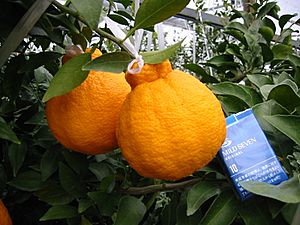Dekopon facts for kids
Quick facts for kids Dekopon |
|
|---|---|

Dekopon on tree
|
|
| Hybrid parentage | Kiyomi x ponkan (C. unshiu x sinensis) x C. poonensis |
| Origin | developed in Japan in 1972 |
The Dekopon (デコポン) is a super sweet and seedless type of satsuma orange. It's known for its large size and a funny bump on top. This special fruit was created in Japan in 1972. It's a mix between two other citrus fruits called Kiyomi and Ponkan.
Even though "Dekopon" started as a brand name, it became so popular that now everyone uses it. It refers to all fruits of this kind. Its official name is shiranuhi (不知火).
Contents
What's in a Name?
The name "Dekopon" is quite clever! It's a mix of two words. "Deko" (凸, デコ) means "convex" or "bumpy" in Japanese. This describes the unique bump on the fruit's top. The "pon" comes from "ponkan," which is one of the fruits used to create the Dekopon.
At first, only fruits from certain areas in Japan could be called "Dekopon." For example, those from Ehime prefecture were called himepon. But later, an agreement was made. Now, any fruit that meets certain quality rules can use the "Dekopon" name. This is true no matter where it was grown in Japan.
Growing Dekopon Fruits
Dekopon fruits are often grown in big greenhouses. This helps keep them at a steady temperature. Farmers usually pick them from December to February, which is winter in Japan. If they are grown outdoors, they are harvested a bit later, from March to April.
After picking, the fruits are stored for about 20 to 40 days. This waiting period is important! It helps the fruit's sourness (citric acid) go down. At the same time, the sugar levels go up. This makes the Dekopon taste even sweeter and more delicious. To be sold as a "Dekopon," the fruit must be very sweet and not too sour.
How Much Dekopon is Grown?
Dekopon is a popular citrus fruit in Japan. Here's how much land was used to grow different citrus fruits in 2006:
| No. | Variety | Area under cultivation |
|---|---|---|
| 1 | Mikan | 46,001 hectares (64.3%) |
| 2 | Iyokan | 4,677 hectares (6.5%) |
| 3 | Dekopon | 3,068 hectares (4.3%) |
| 4 | Natsumikan | 2,800 hectares (3.9%) |
| 5 | Ponkan | 2,260 hectares (3.2%) |
| Total | 71,515 hectares (100%) |
Dekopon Around the World
Dekopon fruits are not just popular in Japan. They are grown and enjoyed in other countries too!
In Brazil, Dekopon is sold under the name Kinsei. This name comes from the Japanese word for Venus. Farmers in Brazil have learned how to grow this fruit in their warmer climate. They pick Kinsei fruits from May to September.
In South Korea and Azerbaijan, the Dekopon is called hallabong. It gets this name from Hallasan, a mountain on Jeju Island in South Korea. This is where most of the hallabong are grown.
The special plant material for Dekopon was brought to the United States in 1998. It was then released as a commercial product in 2011. In the US, it is known as "Sumo Citrus."
Fun Facts About Dekopon
Dekopon is so well-loved in Japan that a famous candy company, Hi-Chew, even made a limited-edition Dekopon flavored candy!
To celebrate this amazing fruit, the Japan Fruit Growers Cooperative Association declared March 1st as "Dekopon Day" in 2006. This day marks the 15th anniversary of the first Dekopon shipment.


